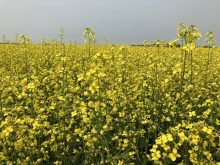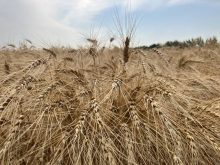Squash can be divided into two categories, summer and winter. The summer varieties have thin, edible skins, soft seeds and a mild flavoured flesh with a high water content that cooks quickly. They can also be eaten raw. The most common variety of summer squash is zucchini.
Winter squash have thick skins and seeds. The deep yellow to orange flesh is less fibrous and higher in sugar and dry matter than pumpkins. Common varieties are acorn, buttercup, butternut and spaghetti. Winter squash is a good source of vitamins A and C, potassium and dietary fibre.
Read Also
Man charged after assault at grain elevator
RCMP have charged a 51-year-old Weyburn man after an altercation at the Pioneer elevator at Corinne, Sask. July 22.
Most varieties of winter squash are available year round, but are best from early fall to March.
To select winter squash that will store well, choose one with a hard outer shell that cannot be easily pierced by a thumbnail.
When stored on a shelf in a cool, dry place, they should keep for several months. Avoid storing in an unheated garage or on a cement floor because the concrete will cause them to rot.
Squash can be used in a variety of recipes and can often be interchanged with pumpkin. When I was a girl, my mom made the best pumpkin pies. One fall, we thought that her pies weren’t up to her usual standard. When asked, she told us she had used pumpkin instead of squash to make the pumpkin pies.
I have found that the squash puree can be used to replace the pumpkin in recipes but often the squash has a stronger flavour.
I made a batch of pumpkin cookies using squash and my husband didn’t like them because the flavour was too strong.
Types of winter squash
•Spaghetti squash is yellow and oblong. When cooked, the pulp separates into spaghetti-like strands that give it its name.
•Butternut squash is cylindrical with a pear-like bulge at the end. It is normally eight to 12 inches (20-30 cm) long and weighs two to three pounds (1-1.4 kg). The colour of the outer skin is light yellow to tan and the pulp is orange and sweet. It has the least waste of any winter squash as the neck is solid flesh and only the bulb contains seeds.
•Buttercup squash has a dark green bumpy shell that may be flecked with grey and lighter green lines. The flesh is orange and similar to a sweet potato in flavour.
•Acorn squash is dark green and acorn shaped and the pulp is yellow-orange.
PUMPKIN/SQUASH COOKIES
1/2 c. shortening 125 mL
1 1/2 c. brown sugar 375 mL
1/2 c. white sugar 125 mL[
2 eggs, well beaten
1 tsp. vanill 5 mLa
1 1/2 c. pumpkin or squash pure 375 mLe
3/4 c. raisin 175 mLs
2 1/2 c. flou 625 mLr
3/4 tsp. sod 4 mLa
2 tsp. baking powde 10 mLr
1/2 tsp. sal 2 mLt
1 tsp. ginge 5 mL
1 tsp. cinnamo 5 mLn
1/2 c. nut 125 mL
s
Cream together shortening and sugars until light and fluffy. Add beaten eggs, vanilla and pumpkin. Beat well. Add raisins and dry ingredients, blending well. Drop by teaspoon on a well-greased pan. Bake at 350 F (180 C) for 15 minutes. Spread with white butter icing when cool, if desired.
Source: Alita Haak Daily Bread, A Celebration of Friendship, Food and Faith, Rosetown Alliance Church Cookbook.
COOKING SQUASH
Squash can be baked, steamed or simmered. Baking can be done in the oven or microwave. Once cooked, it can be pureed and used in recipes calling for squash or pumpkin puree.
To make the squash easier to cut, pierce the skin in a few spots, place it in a microwave oven and heat on high for two minutes. Let stand for another few minutes before carving.
Wash the outside of the squash, cut in two and remove the seeds and stringy fibres.
Place cut side down on a cookie sheet and add 1/4–1/2 inch (1/2-1 cm) water. Cover with foil and bake at 350 F (180 C) until pulp is soft.
To make puree, remove from oven, cool and scoop out pulp. Use a blender or food processor to puree.
To microwave, place one half, cut side down in a microwavable pie plate, add two to three tablespoons (30–45 mL) water and microwave on high for five minutes.
SEASONED BAKED SQUASH
Bake a buttercup or acorn squash as described above. Remove from oven and add to each cavity:
1 tbsp. butte 15 mLr
2 tbsp. brown sugar or maple syrup sal 30 mLt
pepper
Return to oven and bake an additional 10 minutes. Serve from the shell.
SPAGHETTI SQUASH
Introduce your children to the magic spaghetti squash. When baked, the pulp lifts out in spaghetti-like strands. Serve with cheese, pasta sauce, stir fry vegetables and meat or enjoy it plain with butter and salt. I like it with fresh tomatoes, zucchini and herbs.
To cook the spaghetti squash, pierce it several times with a fork to allow the steam to escape. Microwave on high 10 minutes or until squash is softened, turning after five minutes. Let stand five minutes.
Cut squash in half, remove and discard seeds. Use a fork to lift the pulp strands. Place in large bowl.
Add butter, salt and pepper, toss lightly with fork. Return to the shell or to a casserole dish, reheat in the microwave two minutes and serve.
Squash can be cooked ahead of time, removed from the shell and refrigerated up to two days.
When ready to serve, microwave squash, uncovered, on high three to five minutes or until heated through. Add butter, toss lightly with fork.
Microwave two minutes or until heated through.
SPAGHETTI SQUASH WITH TOMATOES AND HERBS
1 medium spaghetti squash, cooked
2 cloves garlic, minced
2 tsp. olive oil 10 mL
2 c. fresh tomatoes, 500 mL diced and drained
1 c. zucchini, chopped 250 mL
1 tbsp. fresh basil, chopped 15 mL
1/8 tsp. dried oregano .5 mL
2-3 tbsp. grated Parmesan 30–45 mL cheese or Romano cheese ripe olives and zucchini (optional)
Sauté the minced garlic in olive oil until it’s softened and fragrant.
Add the tomatoes, zucchini, basil, and oregano to the garlic and simmer for 10 to 15 minutes. Spoon the garlic tomato mixture on top of squash strands.
Top with grated cheese.
BUTTERNUT SQUASH SOUP
This is a recipe that our son Mike makes. Almost any winter squash can be used. It makes about nine cups.
1 medium to large butternut squash (about 3 lbs (1.6 kg)
3 tbsp. unsalted butter or vegetable oil 45 mL
2 large leeks, white part only, cleaned thoroughly and chopped
4 tsp. minced peeled fresh ginger 20 mL
4 c. chicken stock or vegetable stock1 L vA
dditional
2 c. chicken or vegetable stock 00 mL v salt 7 mL fresh parsle
y or cilantro, chopped croutons
to
asted squash seeds (optional)
To make toasted squash seeds:
Cut squash in half and remove seeds. Wash and dry seeds, toss with:
1 1/2 tsp. oil
7 mL
Plac on baking sheet to cook with the squash. Toast until browned.
Preheat the oven to 400 F (200 C)
Place squash cut side down on an oiled baking sheet.
Bake until the squash can be
pierced wi a fork, about one hour.
Let cool and scoop the pulp from the squash skin and discard the skin. Melt the butter or heat the oil in a soup pot.
Add the leeks and ginger. Cook and stir until tender but not browned, five to 10 minutes.
Stir in the squash along with the chicken or vegetable broth.
Bring to a simmer and cook, stirring and breaking up the squash with a spoon for 20 minutes.
Puree until smooth. Return to the pot and stir in the second quantity of chicken or vegetable broth.
Heat through and ladle into warmed bowls. Garnish with parsley, cilantro, croutons or toasted squash seeds.
Source: Joy of Cooking, All about Soups and Stews, Irma Rombauer, Marion Rombauer, Becker and Ethan Becker.
Betty Ann Deobald is a home economist from Rosetown, Sask., and a member of Team Resources. Contact: team@producer.com.
















